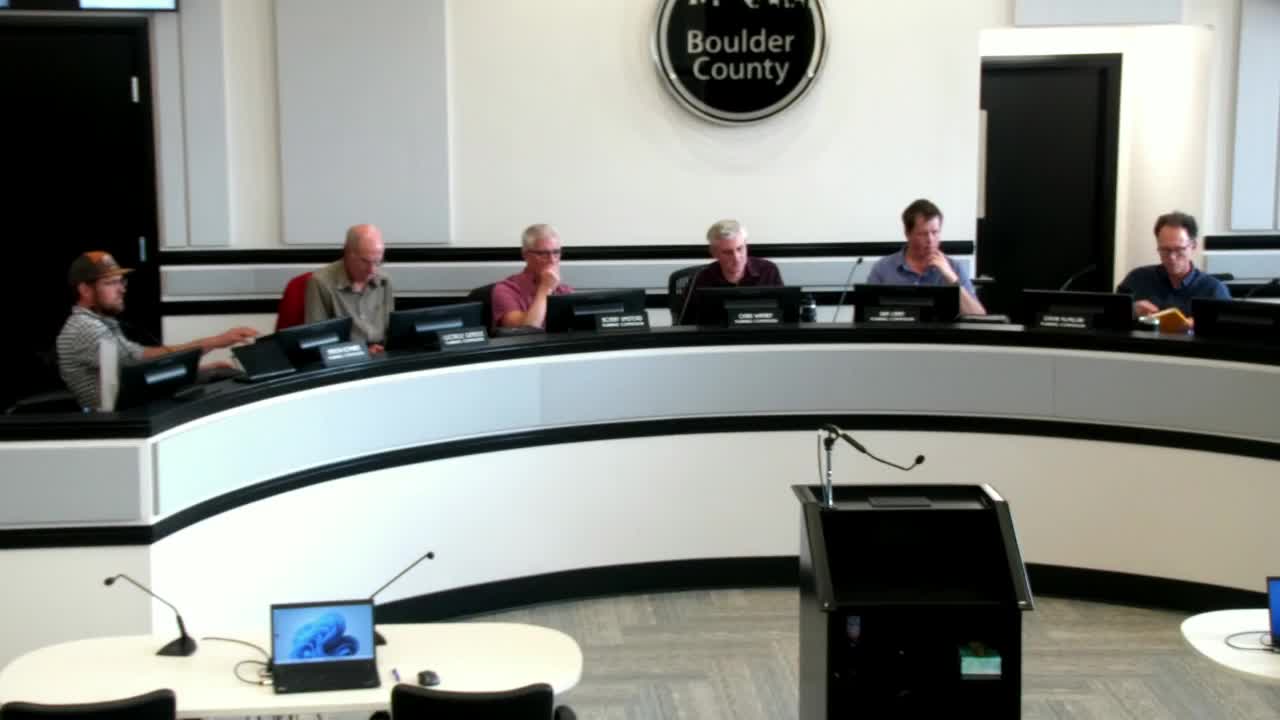Boulder County staff outline zoning enforcement process, case counts and outreach priorities
October 15, 2025 | Boulder County, Colorado
This article was created by AI summarizing key points discussed. AI makes mistakes, so for full details and context, please refer to the video of the full meeting. Please report any errors so we can fix them. Report an error »

Boulder County Community Planning and Permitting presented an overview of the county’s code compliance and public information work at the Oct. 15 Planning Commission meeting, describing how complaints are received, how staff investigate potential land‑use violations and what remedies the county can pursue.
Jesse Raines, who presented the overview for the code compliance and public information team, said the unit does more than zoning enforcement: on‑call planners provide pre‑application guidance to residents, code compliance specialists carry out investigations and CPP coordinates with the county attorney, public health, the sheriff’s office and local fire districts as needed. Raines said the program is complaint‑driven and aims to resolve violations through outreach and negotiated remedies where possible.
Process and remedies: Staff said they begin with an internal investigation using permitting records and aerial imagery and, where authorized, conduct visual inspections from public rights of way. If they find a violation, staff first reach out to property owners and explain necessary remedies and a timeline. Where needed, staff issue 10‑day notices for health‑and‑safety issues or 30‑day notices for less urgent matters. If voluntary compliance does not follow, CPP may refer cases to the county attorney for stipulated agreements or court action; in extreme cases the county can pursue cleanup under Article 14 and recover costs.
Common and difficult cases: Raines said rubbish and related health‑and‑safety situations are among the most difficult enforcement matters, because properties with significant outdoor accumulation often involve social, health or capacity issues for property occupants; such cases can take longer to resolve. Raines also noted that legacy parcels, older structures and conversions (for example inns converted to lodging or residential uses) complicate enforcement because historical approvals and site configurations can be unique.
Staff numbers and outreach: Raines told commissioners that since 2022 the team has opened 654 zoning cases and closed 611. He emphasized outreach — informing property owners and realtors about code requirements and making on‑call staff available — as the best tool to reduce violations. Commissioners asked about common violation types (rubbish, lighting and accessory structures were discussed), geographic patterns, and whether compliance actions can be sequenced with land‑use approvals. Kim Sanchez, deputy director of CPP, said staff routinely coordinates with leadership and attorneys on complex cases and that the department has in the past given property owners limited timeframes to come into compliance on other code changes.
Next steps: Commissioners suggested additional public information and clearer rules where reuse or conversions create ambiguity. Staff said they will continue outreach to realtors and the public and will review processes for clearer sequencing between enforcement and discretionary application review when appropriate.
Ending: Commissioners thanked staff for the overview and asked staff to continue seeking ways to clarify rules and provide early outreach to avoid violations.
Jesse Raines, who presented the overview for the code compliance and public information team, said the unit does more than zoning enforcement: on‑call planners provide pre‑application guidance to residents, code compliance specialists carry out investigations and CPP coordinates with the county attorney, public health, the sheriff’s office and local fire districts as needed. Raines said the program is complaint‑driven and aims to resolve violations through outreach and negotiated remedies where possible.
Process and remedies: Staff said they begin with an internal investigation using permitting records and aerial imagery and, where authorized, conduct visual inspections from public rights of way. If they find a violation, staff first reach out to property owners and explain necessary remedies and a timeline. Where needed, staff issue 10‑day notices for health‑and‑safety issues or 30‑day notices for less urgent matters. If voluntary compliance does not follow, CPP may refer cases to the county attorney for stipulated agreements or court action; in extreme cases the county can pursue cleanup under Article 14 and recover costs.
Common and difficult cases: Raines said rubbish and related health‑and‑safety situations are among the most difficult enforcement matters, because properties with significant outdoor accumulation often involve social, health or capacity issues for property occupants; such cases can take longer to resolve. Raines also noted that legacy parcels, older structures and conversions (for example inns converted to lodging or residential uses) complicate enforcement because historical approvals and site configurations can be unique.
Staff numbers and outreach: Raines told commissioners that since 2022 the team has opened 654 zoning cases and closed 611. He emphasized outreach — informing property owners and realtors about code requirements and making on‑call staff available — as the best tool to reduce violations. Commissioners asked about common violation types (rubbish, lighting and accessory structures were discussed), geographic patterns, and whether compliance actions can be sequenced with land‑use approvals. Kim Sanchez, deputy director of CPP, said staff routinely coordinates with leadership and attorneys on complex cases and that the department has in the past given property owners limited timeframes to come into compliance on other code changes.
Next steps: Commissioners suggested additional public information and clearer rules where reuse or conversions create ambiguity. Staff said they will continue outreach to realtors and the public and will review processes for clearer sequencing between enforcement and discretionary application review when appropriate.
Ending: Commissioners thanked staff for the overview and asked staff to continue seeking ways to clarify rules and provide early outreach to avoid violations.
View the Full Meeting & All Its Details
This article offers just a summary. Unlock complete video, transcripts, and insights as a Founder Member.
✓
Watch full, unedited meeting videos
✓
Search every word spoken in unlimited transcripts
✓
AI summaries & real-time alerts (all government levels)
✓
Permanent access to expanding government content
30-day money-back guarantee

